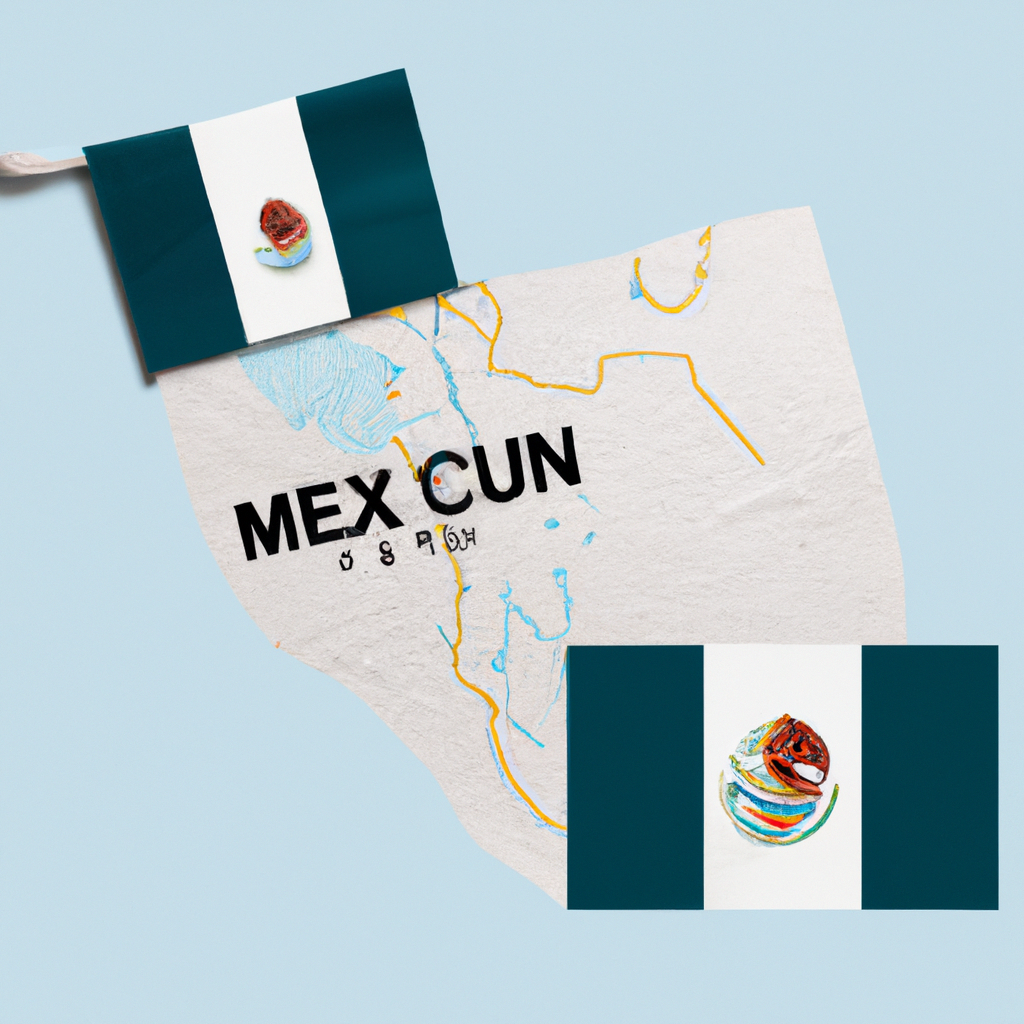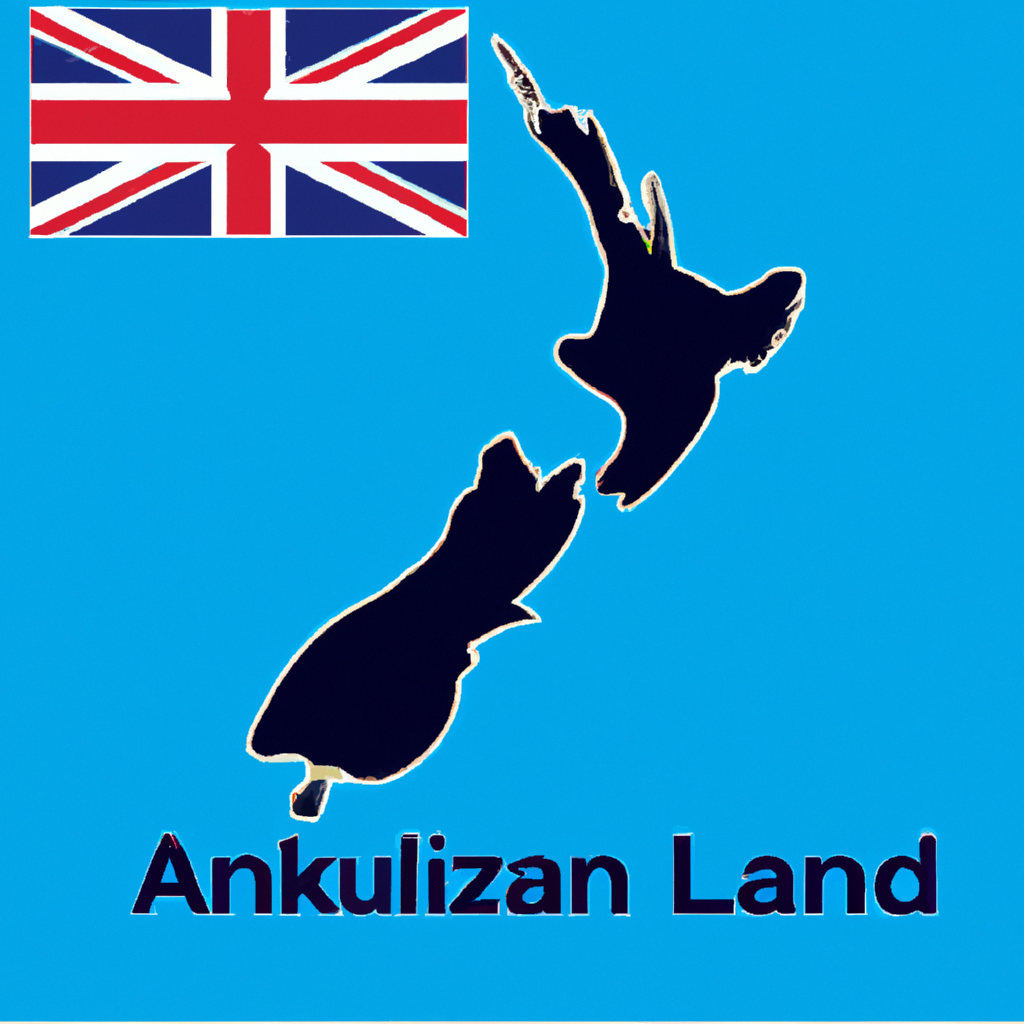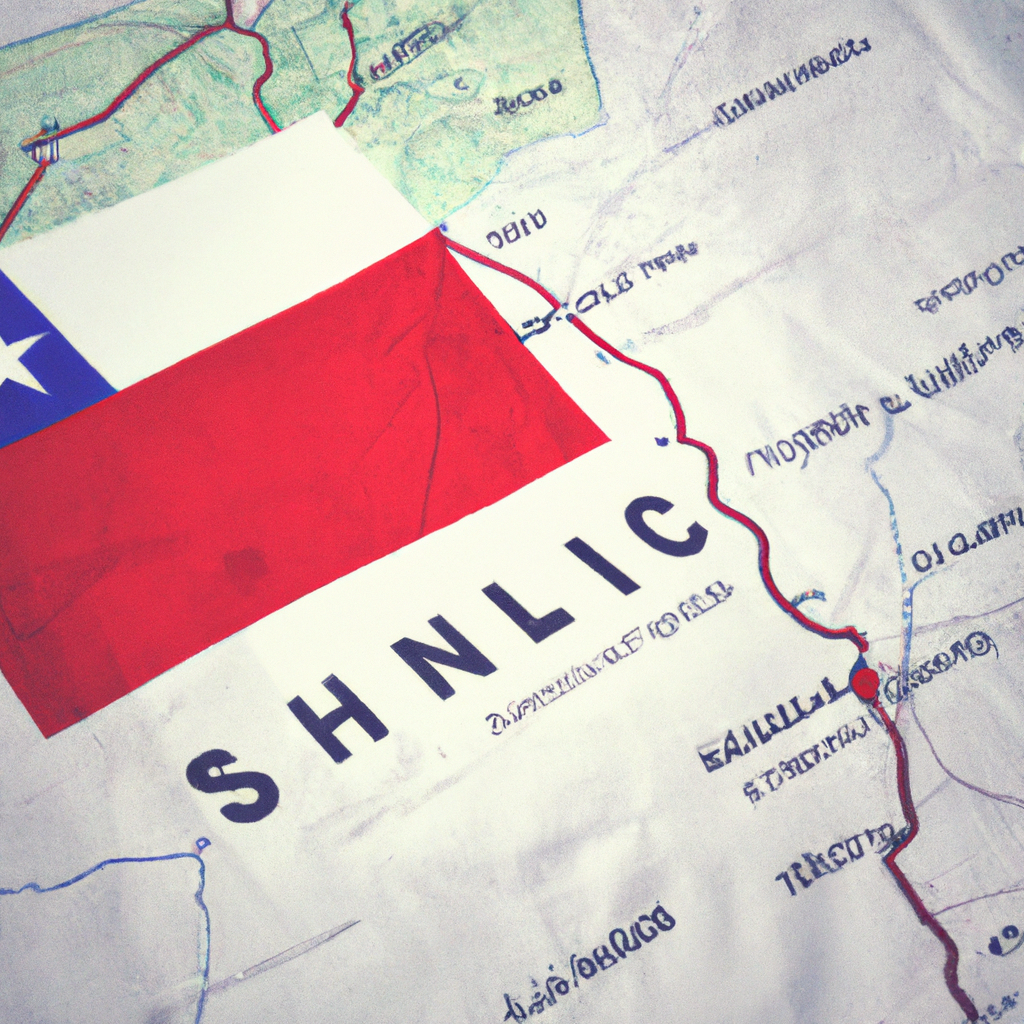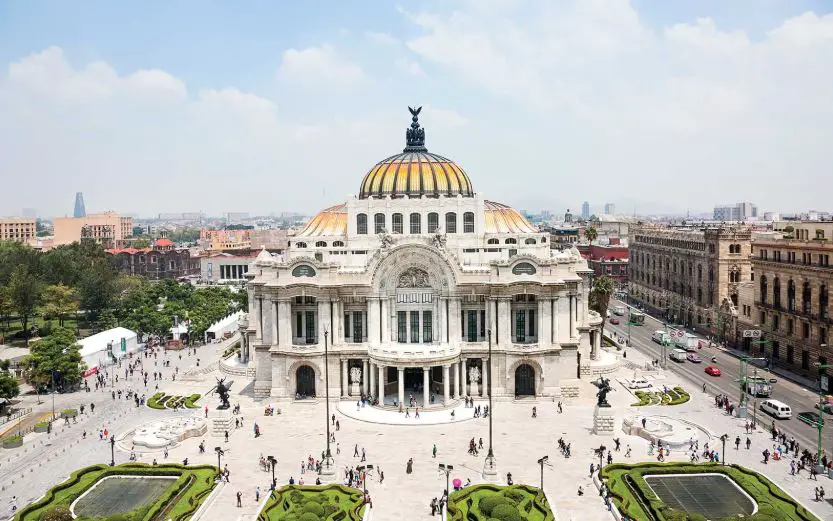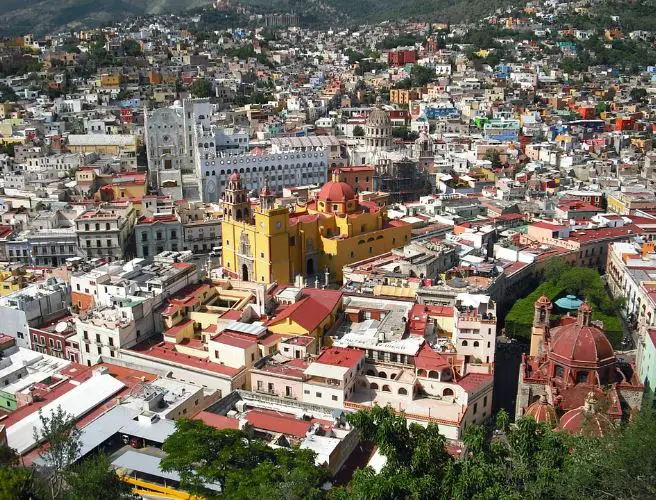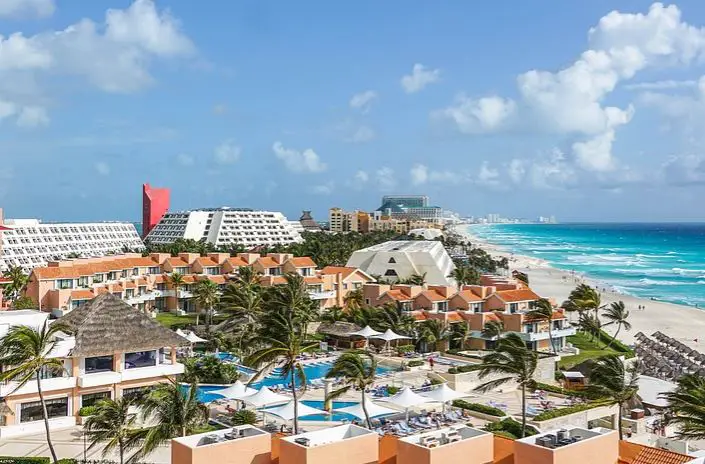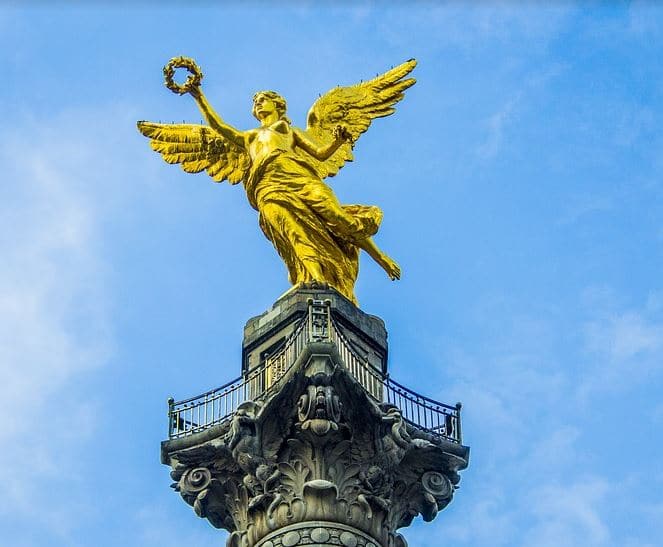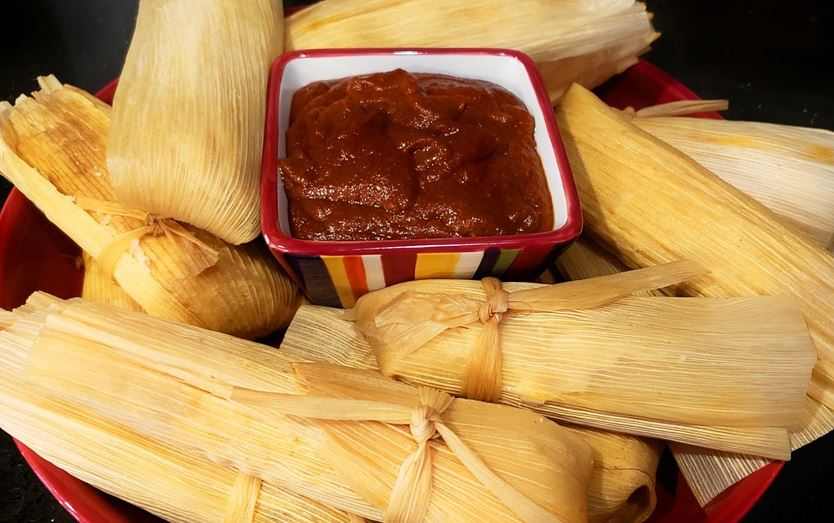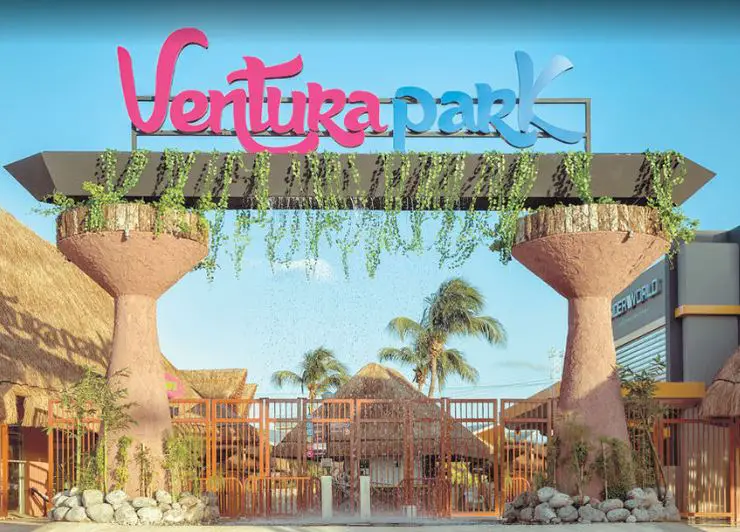Cancún, Mexico: Interesting Facts,History, Things to do,Why to Visit
Post ByAdequate Travel
Cancún, Mexico is a beautiful destination for holiday goers. Situated off the coast of the Yucátan peninsula, Cancún offers something for everyone. From its tropical beaches, to its rich history and culture, not to mention plenty of things to see and do. It's no wonder why Cancún has become one of the most popular tourist destinations in Mexico. If you are planning a trip to this paradise you will want to read up on some amazing and interesting facts about Cancún. Learn more about the history of the area, popular attractions, and some exciting activities that will make your visit a memorable one. Deciding to visit Cancún is not hard, but deciding which of its many attractions to visit may be difficult.
Mexico is a country located in the southern part of North America. It borders the United States to the north and Belize and Guatemala to the south. The country has a diverse landscape, ranging from lush jungles and tropical beaches to arid deserts and snow-capped mountains. Mexico is known for its rich history and vibrant culture, with ancient civilizations such as the Mayans and Aztecs leaving behind impressive ruins and artifacts. The country is famous for its cuisine, including dishes like tacos, enchiladas, and guacamole. Mexico also has a strong economy, with industries such as tourism, manufacturing, and petroleum playing key roles. Despite its natural beauty and cultural heritage, Mexico faces challenges such as crime, poverty, and political corruption. Nevertheless, the country continues to attract millions of tourists every year who are drawn to its unique attractions and warm hospitality.Exploring the city's diverse neighborhoods is one of the best ways to discover the best mexico attractions, each with its own character and charm.
Interesting facts
History
Mexico has a rich and diverse history that dates back thousands of years. The country was home to several advanced civilizations, including the Maya, Aztecs, Toltecs, and Olmecs. The ancient city of Teotihuacan, located near Mexico City, was one of the largest cities in the world during its peak in the first millennium AD.
One interesting fact is that Mexico City is built on top of the ruins of the Aztec city of Tenochtitlan. When the Spanish arrived in the 16th century, they destroyed the Aztec city and built their own capital, which later became Mexico City.
Another significant event in Mexican history is the Mexican Revolution, which took place from 1910 to 1920. This revolution was a major social and political upheaval that led to the overthrow of dictator Porfirio Diaz and the establishment of a more democratic government in Mexico.
Cultural Heritage
Mexico is known for its vibrant and diverse cultural heritage. One iconic aspect of Mexican culture is its cuisine, which includes delicious dishes such as tacos, tamales, and mole sauce. Mexican cuisine has been recognized by UNESCO as an Intangible Cultural Heritage of Humanity.
The country is also famous for its traditional music and dance. Mariachi music, characterized by its lively rhythms and mariachi bands, is a well-known Mexican genre. Additionally, the traditional dance of Mexico, called Folklorico, showcases the diverse regional dances and costumes of the country.
The Day of the Dead (Dia de los Muertos) is a unique Mexican holiday that combines indigenous beliefs with Catholicism. It is celebrated on November 1st and 2nd each year and involves honoring and remembering deceased loved ones. Families create colorful altars called ofrendas and visit cemeteries to decorate gravesites.
Natural Wonders
Mexico boasts a wide range of natural wonders and biodiversity. The country is home to various ecosystems, including deserts, rainforests, mountains, and coastal areas. One well-known natural wonder is the Copper Canyon system, located in the state of Chihuahua. It is a series of canyons that is larger and deeper than the Grand Canyon in the United States.
The Monarch Butterfly Biosphere Reserve is another remarkable natural phenomenon in Mexico. Every year, millions of monarch butterflies migrate to this reserve from Canada and the United States. It is a breathtaking sight to witness the orange and black wings of the butterflies covering the trees in the reserve.
The underwater cave system in the Yucatan Peninsula, known as the Sistema Sac Actun, is the longest underwater cave system in the world. It stretches for over 350 kilometers (217 miles) and is home to a vast array of unique marine life.
From museums to parks,mexico tourist attractions offer something for everyone, making it a versatile destination for all type of tourists.History of Mexico
The history of Mexico dates back to ancient times when it was inhabited by various native civilizations such as the Olmecs, Mayans, and Aztecs. These civilizations flourished in different regions of Mexico and left behind a rich cultural and architectural legacy.
Pre-Columbian Period
During the pre-Columbian period, Mexico was home to several advanced indigenous civilizations. The Olmecs, who lived around 1200-400 BC, are considered the earliest civilization in Mesoamerica and were known for their monumental stone heads.
The Mayans, who thrived between 250 AD and 900 AD, established advanced agricultural systems, developed a hieroglyphic writing system, and built impressive cities with iconic pyramids. Chichen Itza and Palenque are famous examples of Mayan cities.
The most well-known civilization of ancient Mexico is the Aztecs. They founded their capital, Tenochtitlan, in 1325 AD, which is present-day Mexico City. The Aztecs developed a complex social structure, engineering feats such as chinampas (floating gardens), and a unique calendar system.
Spanish Conquest and Colonial Period
In 1519, Spanish conquistador Hernán Cortés arrived in Mexico and initiated the Spanish conquest. After facing various battles and forming alliances with indigenous groups hostile towards the Aztecs, Cortés and his forces conquered the Aztec Empire in 1521, leading to the establishment of Spanish rule.
Mexico became a colony of the Spanish Empire and was referred to as New Spain. The Spanish imposed their culture, language, and religion on the native population. They also introduced new crops, animals, and technologies, transforming the economic and social structure of the region.
Independence and Post-Colonial Era
In the early 19th century, movements for independence began to emerge in Mexico. On September 16, 1810, the Mexican War of Independence was initiated by Miguel Hidalgo, a Catholic priest. After a decade-long struggle, Mexico finally gained independence from Spain in 1821.
However, the post-independence period was marked by political instability and conflicts. Mexico experienced numerous changes in government, including the establishment of various republics, the brief monarchy of Maximilian I, and the dictatorship of Porfirio Díaz.
A significant event in Mexican history is the Mexican Revolution, which started in 1910 and lasted for almost a decade. The revolution aimed to address issues of social inequality, land ownership, and political corruption. The outcome was the establishment of a new constitution and the beginning of a modern democratic era in Mexico.
Modern Mexico
Since the Mexican Revolution, Mexico has experienced periods of economic growth, political challenges, and cultural advancements. The country has become a major player in global industries such as manufacturing, oil production, tourism, and agriculture.
Despite its progress, Mexico faces ongoing issues related to drug trafficking, violence, economic disparities, and corruption. Efforts to address these challenges have been made through government reforms, international cooperation, and initiatives to support education, human rights, and economic development.
Today, Mexico's rich history, diverse culture, and archaeological sites attract visitors from around the world. The country's ancient ruins, vibrant traditions, and culinary delights serve as a testament to its fascinating past.
Exploring the rich heritage of historical sites in mexico is a journey through time and culture.Famous Landmarks in Mexico
1. Chichen Itza: One of Mexico's most famous landmarks, Chichen Itza is an ancient Mayan city located in the Yucatan Peninsula. It is renowned for its impressive pyramid called El Castillo, also known as the Temple of Kukulkan.
2. Palacio de Bellas Artes: This iconic building in Mexico City is a cultural center that showcases various art forms, including painting, sculpture, music, and dance. Its beautiful architecture and stunning murals make it a significant landmark.
3. Teotihuacan: Located near Mexico City, Teotihuacan is an archaeological site that was once a thriving city of the Mesoamerican civilization. It features impressive structures such as the Pyramid of the Sun and the Temple of the Feathered Serpent.
Famous Mexican Artists
1. Frida Kahlo: One of the most celebrated artists worldwide, Frida Kahlo was known for her vibrant and introspective self-portraits. Her work often depicted her physical and emotional pain while exploring themes of identity, gender, and Mexican culture.
2. Diego Rivera: Another influential Mexican artist, Diego Rivera was renowned for his large-scale murals that depicted the history and struggles of the Mexican people. His murals can be found in various locations, including the National Palace in Mexico City.
3. Rufino Tamayo: Tamayo was a prominent painter and printmaker who blended elements of European modernism with Mexican folk art. His use of vibrant colors and abstract forms helped establish him as one of Mexico's most recognized artists.
Famous Mexican Foods
1. Tacos: Tacos are a staple of Mexican cuisine and consist of a tortilla filled with various ingredients such as beef, chicken, pork, or vegetables. They are often topped with salsa, cilantro, onions, and lime.
2. Guacamole: Made from mashed avocados, guacamole is a popular Mexican dip or condiment. It typically includes ingredients like tomatoes, onions, lime juice, and cilantro.
3. Enchiladas: Enchiladas are tortillas filled with a variety of ingredients, such as cheese, chicken, beef, or beans, then rolled, and topped with a chili sauce and cheese before being baked.
These are just a few examples of the famous things in Mexico, ranging from landmarks to art and cuisine. Mexico has a rich cultural heritage and offers an array of experiences for visitors and admirers of its traditions.Discover some unique facts about mexico that will leave you amaze and intrigue.Culture of Mexico
The culture of Mexico is a complex blend of indigenous and Spanish influences. The history of Mexico, with its rich mix of ancient civilizations like the Maya and Aztec, as well as the Spanish conquest and subsequent colonization, has shaped the unique cultural identity of the country.
Language
Mexico is predominantly a Spanish-speaking country, with Spanish being the official language. However, there are also several indigenous languages that are spoken by a significant portion of the population, such as Nahuatl, Maya, and Zapotec.
Art and Literature
Mexico has a vibrant artistic and literary tradition. Mexican art is known for its bright colors, intricate designs, and symbolism. Famous Mexican artists like Frida Kahlo and Diego Rivera have made significant contributions to the world of art. Mexican literature, on the other hand, is diverse and ranges from ancient Mayan texts to works by contemporary authors like Octavio Paz and Carlos Fuentes.
Food
Mexican cuisine is renowned worldwide for its bold flavors and variety. Traditional Mexican dishes include tacos, burritos, enchiladas, tamales, and guacamole, among many others. Mexican food often incorporates ingredients like corn, beans, chili peppers, tomatoes, and avocados. The diversity of regional cuisines within Mexico adds to the richness of the culinary experience.
Religion
The predominant religion in Mexico is Catholicism, which was introduced by the Spanish during the colonial period. However, there is also a significant presence of other religious practices, such as indigenous beliefs and a growing number of Protestant denominations.
Celebrations and Holidays
Mexico is known for its vibrant celebrations and colorful festivals. One of the most famous celebrations is Día de los Muertos (Day of the Dead), a unique tradition that honors deceased loved ones. Other important holidays include Cinco de Mayo, Independence Day, and Christmas. These celebrations often involve music, dancing, parades, and traditional costumes.
Overall, Mexican culture is a mix of ancient traditions and influences from various historical periods. it is a culturally diverse country that embraces its indigenous heritage while incorporating elements from European colonization. From its language and art to its cuisine and festivities, Mexico's cultural richness is a testament to its fascinating history.Immerse yourself in the local culture by exploring mexico's top-rated tourist attractions.Cuisine of Mexico
The cuisine of Mexico is known for its bold and vibrant flavors, combining traditional indigenous ingredients with European influences. Mexican cuisine is diverse and varies across regions, but there are common elements and dishes that are enjoyed nationwide.
Popular Mexican Dishes
Some of the most well-known Mexican dishes include:
- Tacos: A staple in Mexican cuisine, tacos can be made with various fillings such as grilled meats, fish, shrimp, or vegetables, and are often topped with salsa, guacamole, and cheese.
- Enchiladas: Tortillas filled with meat, cheese, or beans, rolled up, and topped with a chili sauce. They are usually served with rice and beans.
- Tamales: Corn masa dough filled with various ingredients, such as meat, cheese, or vegetables, wrapped in corn husks, and steamed.
- Mole: A rich and complex sauce made with chili peppers, spices, and often chocolate. It is usually served with chicken or pork.
- Chiles Rellenos: Large, mild chili peppers stuffed with cheese and/or meat, battered, and fried. They are often served with tomato sauce.
- Guacamole: A delicious avocado-based dip or spread, typically made with mashed avocados, lime juice, onions, tomatoes, and cilantro.
Regional Specialties
Mexico is a vast country with diverse regional cuisines. Here are some examples of regional specialties:
- Yucatecan Cuisine: Known for its Mayan influence, Yucatecan cuisine includes dishes like cochinita pibil (marinated and slow-roasted pork) and panuchos (fried tortillas filled with black beans and topped with shredded chicken or turkey).
- Oaxacan Cuisine: Famous for its moles, Oaxacan cuisine highlights traditional ingredients such as chocolate, tlayudas (large crispy tortillas topped with various toppings), and mezcal (a distilled alcoholic beverage).
- Northern Cuisine: In northern Mexico, dishes like carne asada (grilled beef), cabrito (roast goat), and flour tortillas are popular.
- Veracruz Cuisine: With its coastal location, Veracruz cuisine features seafood dishes such as huachinango a la Veracruzana (red snapper in a savory tomato sauce), and bocoles (small corn tortillas stuffed with beans and cheese).
Mexican cuisine is not only delicious but also reflects the country's rich cultural heritage. Whether you are a fan of spicy flavors, fresh ingredients, or indulgent dishes, Mexican cuisine offers a wide range of options to satisfy your taste buds.
mexico tourist attractions offer a diverse range of experiences for every traveler.1. Explore the Ancient Mayan Ruins
Mexico is home to several ancient Mayan ruins that are not only historically significant but also visually stunning. One of the most popular sites to visit is Chichen Itza, located in the Yucatan Peninsula. This breathtaking archaeological site offers a glimpse into the Mayan civilization with its iconic pyramid-shaped El Castillo temple, as well as other impressive structures such as the Temple of Warriors and the Great Ball Court.
Another must-visit Mayan ruin is Tulum, situated on the Caribbean coastline. The site is perched on a cliff overlooking the turquoise waters, giving it a picturesque setting. The ruins of Tulum include well-preserved temples, a ceremonial center, and a stunning beach below, making it a favorite among history buffs and beach lovers.
2. Indulge in Mexican Cuisine
Mexico is renowned for its flavorful and diverse cuisine. Exploring the local food scene is a must when visiting the country. From street tacos and tamales to mole and ceviche, there is an endless variety of traditional dishes to try.
Make sure to visit local markets, such as Mercado de San Juan in Mexico City or Mercado 28 in Cancun, where you can sample an array of authentic Mexican street food. Don't forget to indulge in the famous Mexican street corn, known as elote, which is typically grilled and topped with mayo, cheese, chili powder, and lime.
3. Relax on Mexico's Beautiful Beaches
Mexico is renowned for its breathtaking beaches, offering crystal-clear waters, golden sand, and stunning views. Whether you prefer snorkeling, sunbathing, or simply enjoying a leisurely walk along the shore, there are plenty of beach destinations to choose from.
One notable beach destination is Playa del Carmen, located on the Riviera Maya. It offers a vibrant beachfront lined with shops, restaurants, and bars. You can also visit nearby Cozumel Island, known for its excellent diving spots.
Another popular beach destination is Cancun, famous for its palm-fringed shores and vibrant nightlife. You can relax on the pristine white sandy beaches during the day and explore the bustling Hotel Zone in the evening.
4. Experience the Rich Cultural Heritage
Mexico has a rich cultural heritage, influenced by various indigenous civilizations and colonial history. Exploring the country's cultural sites and traditions is a fascinating experience.
Visit Mexico City's historic center, where you can explore the majestic Zocalo square, home to the Metropolitan Cathedral and the National Palace. Take a stroll along the famous Reforma Avenue, lined with monuments and beautiful architecture.
Additionally, experiencing traditional Mexican festivals and celebrations, such as Dia de los Muertos (Day of the Dead) or Semana Santa (Holy Week), provides a unique insight into the country's culture and traditions.
5. Discover Mexico's Natural Wonders
Mexico boasts a diverse range of natural wonders, from majestic cenotes to lush jungles and impressive canyons.
One natural wonder worth exploring is Hierve el Agua, located in Oaxaca. It is a set of petrified waterfalls formed by mineral-rich springs. The site offers stunning views, and visitors can swim in the crystal-clear natural infinity pools.
Another incredible natural wonder is the Sumidero Canyon in Chiapas. This impressive canyon stretches over 1,000 meters high and offers breathtaking views from boat tours that navigate through the Grijalva River.
These are just a few examples of the many incredible things you can do in Mexico. The country offers a plethora of experiences, from historical and cultural delights to natural marvels and delicious cuisine.When planning your trip to mexico, be sure to include the best things to do in mexico, which encompass a wide range of cultural experiences.Climate of Mexico
Mexico has a diverse climate due to its large size and varied topography. The country is located in the tropics, but its climate is influenced by its proximity to two major bodies of water - the Pacific Ocean and the Gulf of Mexico. As a result, Mexico experiences a range of climates, from tropical to desert to temperate, depending on the region.
Tropical Climate
- The coastal areas along the Gulf of Mexico and the Pacific Ocean have a tropical climate, characterized by high temperatures and humidity throughout the year.- These regions receive high amounts of rainfall, particularly during the summer months when tropical storms and hurricanes are common.
- Examples of cities with a tropical climate in Mexico include Cancun, Veracruz, and Acapulco.
Desert Climate
- Some regions, such as parts of Baja California and the northern states of Sonora and Chihuahua, have a desert climate.- These areas experience extremely hot summers and very low precipitation, making them arid and dry.
- Examples of cities with a desert climate in Mexico include Mexicali and Hermosillo.
Temperate Climate
- The central highlands of Mexico, including Mexico City and Guadalajara, have a temperate climate.- These areas enjoy mild to warm temperatures year-round, with cooler temperatures at higher elevations.
- They also experience distinct wet and dry seasons, with higher rainfall during the summer months.
- Examples of cities with a temperate climate in Mexico include Mexico City, Guadalajara, and Puebla.
Mountainous Climate
- Mountainous regions, such as the Sierra Madre Occidental and Sierra Madre Oriental, have a mountainous climate.- These areas experience cooler temperatures due to their high elevation, with colder winters and milder summers.
- Precipitation levels vary based on location and elevation, with some areas receiving moderate to high amounts of rainfall.
- Examples of cities with a mountainous climate in Mexico include Monterrey and Durango.
In conclusion, Mexico's climate is diverse and influenced by various factors including its proximity to water bodies, topography, and latitude. This diversity results in different climates throughout the country, ranging from tropical and desert climates to temperate and mountainous climates. Each region has its own unique weather patterns and conditions, offering a variety of climates for visitors and residents to experience.
Exploring the city's diverse neighborhoods is one of the best ways to discover the best mexico attractions, each with its own character and charm.Popular Activities in Mexico
1. Exploring Ancient Mayan Ruins
The rich history of Mexico offers a chance to explore ancient Mayan ruins, which are scattered throughout the country. Some popular sites include Chichen Itza, Tulum, and Palenque. These ruins provide a glimpse into the ancient civilization and their remarkable architecture.
2. Trying Authentic Mexican Cuisine
Mexico is renowned for its delicious and diverse cuisine. From street tacos to mole sauces, there are numerous regional dishes to try. Mexican cuisine is known for its bold flavors and vibrant ingredients, such as chilies, avocado, cilantro, and corn. Don't miss sampling traditional dishes like pozole, enchiladas, and chiles en nogada.
3. Relaxing on Beautiful Beaches
With coasts along the Pacific Ocean, Gulf of Mexico, and the Caribbean Sea, Mexico boasts stunning beaches. Popular beach destinations include Cancun, Playa del Carmen, and Tulum. Visitors can enjoy sunbathing, swimming, snorkeling, and water sports. Many beaches also offer vibrant nightlife and beachside restaurants and bars.
4. Discovering Colonial Cities
Mexico is home to several charming colonial cities with picturesque architecture and cobblestone streets. Cities such as Guanajuato, San Miguel de Allende, and Queretaro offer a glimpse into Mexico's colonial past and provide opportunities for exploring historic buildings, churches, and plazas.
5. Experiencing Traditional Festivals
Mexico is known for its vibrant and colorful festivals, which celebrate religious, cultural, and historical events. One of the most famous festivals is Dia de los Muertos (Day of the Dead), celebrated at the end of October and beginning of November. Other popular festivals include Guelaguetza, Carnival, and Independence Day celebrations.
Plan your trip with a list of the best things to do in mexico, catering to all interests.HTML Code:```html
Nightlife in Mexico
1. Clubs and Bars: Mexico is known for its vibrant nightlife with numerous clubs and bars offering a variety of music, dancing, and entertainment options. Some popular nightlife destinations include Zona Rosa in Mexico City, Playa del Carmen, and Puerto Vallarta.2. Live Music Venues: Mexico has a rich music culture, and live music venues are a popular choice for locals and tourists alike. From traditional Mexican music to international artists, there are plenty of options to enjoy live performances.3. Night Markets and Street Food: Mexico is famous for its street food, and at night, various night markets and street food vendors offer a wide range of delicious and affordable food options. These markets create a lively atmosphere where people can socialize and indulge in culinary delights.4. Rooftop Bars: Many cities in Mexico have rooftop bars, providing stunning views of the city skyline along with a trendy and sophisticated atmosphere. These bars are an ideal spot to relax, have a few drinks, and enjoy the cityscape.5. Festivals and Celebrations: Mexico is known for its colorful festivals and celebrations, which often extend into the night. From Day of the Dead celebrations to traditional fiestas, these events offer a unique and exciting nightlife experience.6. Beach Parties: Mexico boasts beautiful beaches, and beach parties are a popular nighttime activity. Whether it's a bonfire, live music, or beach clubs, there are plenty of options for partygoers to enjoy the beach atmosphere after dark.7. LGBTQ+ Nightlife: Mexico has a vibrant LGBTQ+ community, and cities like Mexico City and Puerto Vallarta have a lively LGBTQ+ nightlife scene. LGBTQ+ clubs, bars, and parties provide a safe and inclusive space for people from the community and allies.8. Cultural Performances: Mexico's rich cultural heritage is reflected in various performances, such as traditional dances, theater shows, and art exhibitions. These performances often take place in the evenings, offering a unique and immersive cultural experience.9. Pub Crawls and Bar Hopping: For those looking to explore multiple bars and clubs in one night, pub crawls and bar hopping are popular activities. Organized tours take participants to different establishments, allowing them to experience the diversity of Mexico's nightlife.10. Casinos and Gaming: If you're feeling lucky, Mexico has several casinos where you can try your hand at various games and gambling activities. These establishments often have additional entertainment options like live music and shows.```Explanation:The above HTML code provides an example of using HTML tags to create a structured document. The heading "Nightlife in Mexico" is enclosed within the `` tag, which represents the fifth level heading in HTML.Within the `
` tag, several paragraphs provide detailed information about the nightlife in Mexico. Each point is numbered and explained in detail. The examples are enclosed within `
` tags to represent separate paragraphs.
The HTML structure helps to organize and present the information in a clear and hierarchical manner, making it easier for users to read and understand the content.Discover the untold stories behind mexico unique facts, and historical treasures.Reasons to Visit Mexico
There are countless reasons why you should consider visiting Mexico. This diverse country offers something for every type of traveler, from beautiful beaches to ancient ruins, vibrant cities to picturesque colonial towns. Here are some compelling reasons to visit Mexico:
1. Rich History and Cultural Heritage
Mexico boasts a rich history that spans over thousands of years. From the ancient Mayan ruins of Chichen Itza to the Aztec temples of Teotihuacan, there are numerous archaeological sites to explore. The country is also known for its vibrant cultural traditions, celebrating festivals such as Dia de los Muertos (Day of the Dead) and hosting colorful folkloric dances.
2. Stunning Beaches
Mexico is home to some of the most beautiful beaches in the world. From the turquoise waters and powdery white sands of Cancun and the Riviera Maya to the secluded coves of Tulum and the Pacific coastline of Baja California, there is a beach for every taste. Whether you enjoy relaxing under a palm tree or engaging in water sports like snorkeling and surfing, Mexico's beaches won't disappoint.
3. Culinary Delights
Mexico is renowned for its delicious cuisine. From street tacos and mouth-watering tamales to ceviche and mole, Mexican food offers a wide range of flavors and dishes. Each region has its own specialties, such as Yucatecan cuisine in the Yucatan Peninsula or seafood in the coastal areas. Don't miss the opportunity to try authentic Mexican dishes and indulge in the local flavors.
4. Natural Wonders
Mexico is blessed with diverse natural landscapes. From the breathtaking Copper Canyon, which is even larger than the Grand Canyon, to the stunning waterfalls of Chiapas and the unique biosphere reserve of Sian Ka'an, there are plenty of natural wonders to explore. Mexico also hosts an impressive array of wildlife, including sea turtles, jaguars, and vibrant bird species.
5. Vibrant Cities
Mexico's cities are vibrant and full of life. Mexico City, the capital, offers a mix of historic sites, modern architecture, and a bustling arts scene. Guadalajara is known for its mariachi music and tequila distilleries, while Oaxaca offers colonial charm and a renowned culinary scene. The coastal city of Puerto Vallarta is famous for its beautiful beaches and lively nightlife.
In summary, Mexico is a country that offers a wide range of attractions and experiences for travelers. Its rich history, stunning beaches, delicious cuisine, natural wonders, and vibrant cities make it a captivating destination to explore.Whether you're a history buff or an adventure seeker, mexico has an attraction for you. So, don't miss the chance to visit popular places in mexicoNumber of Days Required to Visit Mexico
In order to determine the number of days required to visit Mexico, it depends on several factors such as the places you plan to visit, the activities you want to engage in, and your personal preferences. Mexico is a diverse country with a rich cultural heritage, stunning natural landscapes, and vibrant cities, offering a range of attractions for different types of travelers.
Factors to Consider:
1. Destination: The number of days required for your trip depends on the specific destinations you want to explore. If you plan to visit only one city, such as Mexico City, you could typically spend around 3-4 days exploring its various attractions like the historic center, museums, and nearby archaeological sites.
2. Activities: The activities you want to participate in will influence the duration of your trip. For example, if you're interested in exploring the Mayan ruins in the Yucatan Peninsula, it would require additional days to travel between different sites like Chichen Itza, Tulum, and Uxmal.
3. Transportation: The time required for traveling between destinations should also be taken into account. Mexico has an extensive transportation network, but long distances may require additional days for travel.
4. Leisure vs. Fast-paced Trip: The pace of your trip can also affect the number of days needed to visit Mexico. If you prefer a more relaxed itinerary with ample leisure time, you may want to allocate more days to each destination. Alternatively, if you're on a tight schedule and want to cover multiple places quickly, you may need fewer days in each location.
Example Itineraries:
Option 1: Mexico City and Surroundings (Approximately 7-10 days)
- Day 1-4: Explore the historic center of Mexico City, including the Zocalo, Palacio de Bellas Artes, and Museo Frida Kahlo.
- Day 5: Take a day trip to Teotihuacan to witness the ancient pyramids.
- Day 6-7: Visit the nearby city of Puebla and enjoy its colonial architecture and delicious cuisine.
- Day 8-10: Explore the colorful town of Taxco and the stunning natural landscapes of Hierve el Agua in Oaxaca.
Option 2: Yucatan Peninsula (Approximately 10-14 days)
- Day 1-3: Start in Cancun and relax on the beautiful beaches.
- Day 4-6: Explore the Mayan ruins of Tulum and relax in Playa del Carmen.
- Day 7-10: Visit Chichen Itza, Uxmal, and Merida to immerse yourself in Mayan history and culture.
- Day 11-14: Discover the natural wonders of cenotes and explore the colorful city of Valladolid.
It's important to note that these example itineraries are just suggestions, and you can customize your trip based on your interests and available time. The number of days required may also vary depending on the pace at which you want to experience each destination. Planning in advance and researching the attractions and distances between places will help you determine the ideal duration for your visit to Mexico.mexico tourist attractions offer a diverse range of experiences for every traveler.Significance of Mexico
Mexico is a country of great historical, cultural, and geographical significance. Here are some key points highlighting its importance:
1. Historical Significance
Mexico has a rich and complex history that spans thousands of years. It was the home of ancient civilizations such as the Maya, Aztec, and Olmec, which built impressive cities, developed advanced writing systems, and made significant contributions to art, architecture, and mathematics. The conquest of Mexico by the Spanish in the 16th century led to the fusion of indigenous and European cultures, resulting in the birth of modern Mexican identity.
2. Cultural Significance
Mexican culture is known for its vibrant and diverse traditions, including the Day of the Dead, traditional music like mariachi, colorful folk art, and delicious cuisine. The country's cultural heritage is recognized globally, and its art, literature, music, and film have had a significant impact on the world stage. Icons like Frida Kahlo, Octavio Paz, and Gabriel García Márquez have earned international acclaim for their contributions to their respective fields.
3. Geographical Significance
Mexico is strategically located between the United States and Central America. Its extensive coastline encompasses the Gulf of Mexico, the Caribbean Sea, and the Pacific Ocean, making it a hub for international trade and tourism. Furthermore, Mexico is home to diverse ecosystems, including tropical rainforests, deserts, mountains, and beaches, providing tremendous opportunities for biodiversity conservation and ecotourism.
Overall, Mexico's historical, cultural, and geographical significance makes it a fascinating country to explore and study. It has shaped the course of history, influenced global culture, and offers a wide range of natural wonders and cultural treasures for locals and visitors alike.
From hidden gems to iconic landmarks, mexico has something for every traveler's taste.1. What is the currency of Mexico?
The currency of Mexico is the Mexican Peso (MXN). It is represented by the symbol "$" or "M$". The peso is divided into 100 centavos. Some examples of Mexican coins include the 1 peso coin, 5 peso coin, and 10 peso coin. Banknotes are available in denominations of 20, 50, 100, 200, 500, and 1000 pesos.
2. What is the official language of Mexico?
The official language of Mexico is Spanish. Spanish is spoken by the majority of the population in Mexico, and it is also the most widely used language for official and business purposes. Indigenous languages are also spoken in certain regions of Mexico, such as Nahuatl, Yucatec Maya, and Mixtec.
3. What are some popular tourist destinations in Mexico?
Mexico offers a wide range of popular tourist destinations. Some examples include:
Cancun: Known for its beautiful beaches and vibrant nightlife.
Mexico City: The capital city that offers cultural attractions, historical landmarks, and delicious cuisine.
Playa del Carmen: Located on the Riviera Maya, it is famous for its stunning beaches and snorkeling opportunities.
Tulum: Known for its ancient Mayan ruins and picturesque coastal views.
Chichen Itza: A UNESCO World Heritage site featuring impressive Mayan ruins.
4. What is the weather like in Mexico?
Mexico has diverse climates due to its size and topography. Generally, it experiences a tropical or subtropical climate. Coastal areas are typically warm and humid, while higher altitude regions can have mild or cooler temperatures. The Yucatan Peninsula, for example, has a tropical climate with hot and humid summers and warm winters.
5. What is the traditional cuisine of Mexico?
Mexican cuisine is known for its rich flavors and diverse ingredients. Some iconic dishes include:
Tacos: A popular street food made with tortillas filled with various meats, vegetables, and salsas.
Enchiladas: Corn tortillas rolled around a filling, topped with sauce and cheese.
Mole: A traditional sauce made with chili peppers, chocolate, and spices, often served over meats.
Guisados: Slow-cooked stews with meat or vegetables, often served with rice and beans.
Tamales: Steamed corn dough filled with various fillings, such as meats, cheese, or vegetables.
